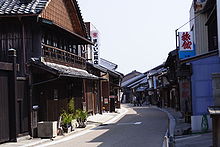- Seki-juku (Tōkaidō)
-
Attention : Il existe aussi un relai Seki-juku sur le Mikuni Kaidō
 Seki-juku dans les années 1830, représenté par Hiroshige dans les Cinquante-trois Stations du Tōkaidō
Seki-juku dans les années 1830, représenté par Hiroshige dans les Cinquante-trois Stations du Tōkaidō
Seki-juku était la quarante-septième des 53 stations qui jalonnaient la route du Tōkaidō, qui constituait l'axe principal du Japon de l'ère Edo. Elle se situait dans l'actuelle ville de Kameyama, dans la préfecture de Mie, au Japon[1].
Sommaire
Histoire
La région autour de Seki-juku a toujours consititué un important carrefour pour les voyageurs. À l'époque de la guerre de Jinshin, en 672 CE, on la connaissait comme l'un des « Trois Anciens Seki », sous le nom du « Seki d'Ise Suzuka » (伊勢鈴鹿の関 Ise Suzuka no Seki). Durant l'ère Edo, c'était une shukuba, une station d'étape, très animée, car c'était ici que les routes Isebetsu Kaidō (伊勢別街道) et Yamato Kaidō (大和街道) se croisaient avec celle du Tōkaidō.
Beaucoup des bâtiments historiques ont été préservés, et la région est devenue un site de conservation de l'architecture nationale[1].
Stations d'étape adjacentes
En allant d'Edo, capitale du shogun, vers Kyoto, capitale de l'empereur, le voyageur passait d'abord par la station de Kameyama-juku, avant de continuer ensuite sur celle de Sakashita-juku (Sakanoshita).
- Kameyama-juku - Seki-juku - Sakashita-juku
Notes et références
- Mie Tourism Guide : Ancient Tokaido Seki-juku, sur welcome.kankomie.or.jp, site de la préfecture de Mie
- (en) Cet article est partiellement ou en totalité issu de l’article de Wikipédia en anglais intitulé « Seki-juku (Tōkaidō) » (voir la liste des auteurs).
Sources
- (en) Patrick Carey, Rediscovering the Old Tokaido:In the Footsteps of Hiroshige, Global Books UK, 2000 (ISBN 1901903109)
- (en) Reiko Chiba, Hiroshige's Tokaido in Prints and Poetry, Tuttle, 1982 (ISBN 0804802467)
- (en) Jilly Traganou, The Tōkaidō road: traveling and representation in Edo and Meiji Japan, Routledge, 2004 (ISBN 9780415310918)
- Gisèle Lambert et Jocelyn Bouquillard, Le Tōkaidō d'Hiroshige, Bibliothèque de l'image, 2002 (ISBN 2-914239-69-6)
Articles connexes
{{DEFAULTSORT:Seki-juku (Tokaido)Route du Japon
Wikimedia Foundation. 2010.

